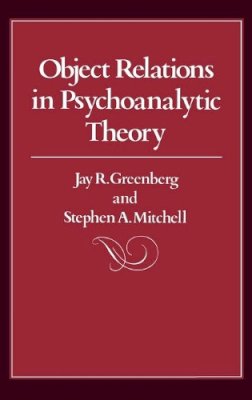12%OFF
Stock image for illustration purposes only - book cover, edition or condition may vary.
Object Relations in Psychoanalytic Theory
Jay R. Greenberg
FREE Delivery in Ireland
Description for Object Relations in Psychoanalytic Theory
Hardcover. Examines the theories of Freud, Sullivan, Fromm, Jacobson, and other psychologists regarding interpersonal relationships. Num Pages: 456 pages, bibliography, index. BIC Classification: JMAF. Category: (P) Professional & Vocational; (UP) Postgraduate, Research & Scholarly; (UU) Undergraduate. Dimension: 243 x 165 x 34. Weight in Grams: 800.
Object Relations in Psychoanalytic Theory provides a masterful overview of the central issue concerning psychoanalysts today: finding a way to deal in theoretical terms with the importance of the patient's relationships with other people. Just as disturbed and distorted relationships lie at the core of the patient's distress, so too does the relation between analyst and patient play a key role in the analytic process. All psychoanalytic theories recognize the clinical centrality of “object relations,” but much else about the concept is in dispute. In their ground-breaking exercise in comparative psychoanalysis, the authors offer a new way to understand the ... Read moredramatic and confusing proliferation of approaches to object relations. The result is major clarification of the history of psychoanalysis and a reliable guide to the fundamental issues that unite and divide the field.
Greenberg and Mitchell, both psychoanalysts in private practice in New York, locate much of the variation in the concept of object relations between two deeply divergent models of psychoanalysis: Freud's model, in which relations with others are determined by the individual's need to satisfy primary instinctual drives, and an alternative model, in which relationships are taken as primary. The authors then diagnose the history of disagreement about object relations as a product of competition between these disparate paradigms. Within this framework, Sullivan's interpersonal psychiatry and the British tradition of object relations theory, led by Klein, Fairbairn, Winnicott, and Guntrip, are shown to be united by their rejection of significant aspects of Freud's drive theory. In contrast, the American ego psychology of Hartmann, Jacobson, and Kernberg appears as an effort to enlarge the classical drive theory to accommodate information derived from the study of object relations.
Object Relations in Psychoanalytic Theory offers a conceptual map of the most difficult terrain in psychoanalysis and a history of its most complex disputes. In exploring the counterpoint between different psychoanalytic schools and traditions, it provides a synthetic perspective that is a major contribution to the advance of psychoanalytic thought.
Show Less
Product Details
Publisher
Harvard University Press United States
Place of Publication
Cambridge, Mass, United States
Shipping Time
Usually ships in 7 to 11 working days
Reviews for Object Relations in Psychoanalytic Theory
We are…fortunate that we have the likes of Greenberg and Mitchell to provide us with a first-class study in comparative psychoanalysis to help us keep our minds open. The authors summarize the contributions of Sigmund Freud, H. S. Sullivan, Erich Fromm, Melanie Klein, W. R. D. Fairbairn, D. W. Winnicott, Harry Guntrip, Heinz Hartmann, Margaret Mahler, Edith Jacobson, Otto Kernberg, ... Read moreHeinz Kohut, and Joseph Sandler, organizing these presentations around the particular visions of object relations each has offered… This is a splendid book for several reasons. Its intent embodies the best attitudes in psychoanalysis, and its execution is very sophisticated and instructive. It certainly deserves your study.
Jeffrey J. Andresen, M.D.
Contemporary Psychiatry
That the neo-Freudians and the British object-relations theorists emphasize relationships is well known. What is not well known, and what constitutes Greenberg and Mitchell’s special contribution, is the idea that accounting for relationships may be a defining task of all psychoanalytic theorizing and that the various theories can usefully be categorized, contrasted, and understood in terms of their particular strategies for doing so… Greenberg and Mitchell’s book provides access to this difficult literature. Their discussions of the various psychoanalytic theories are scholarly, convincing, and packed with clever connections and intriguing observations… [The book] provides a long-sought path through the thicket of psychoanalytic writing.
Daniel B. Wile
Contemporary Psychology
A most valuable contribution to the psychoanalytic literature. The authors have undertaken to review all of the psychoanalytic theories concerning object relationships, comparing and contrasting the ‘classical’ theory with derivatives of it and the important theories which have arisen in opposition to it… It increases the value of the book to readers at all levels that they have elected to make their reviews of the various theories quite full, so that it is possible really to learn something about each theory in some depth… The authors have considered each position from the point of view of its internal logic, correspondence to the clinical data, and how well it seems to answer the problems which it set out to solve… This is a splendid book.
Adrienne Applegarth
International Journal of Psycho-Analysis
Presenting the material in admirable clarity, [the authors] provide an excellent overview of the major forces in current psychoanalytic theory as well as connecting those forces to sociological and cultural concepts in a creative way. Highly recommended.
Library Journal
Show Less


